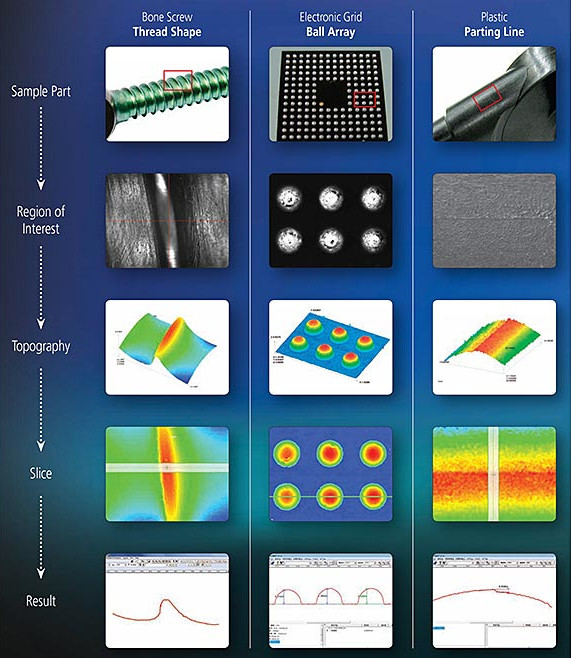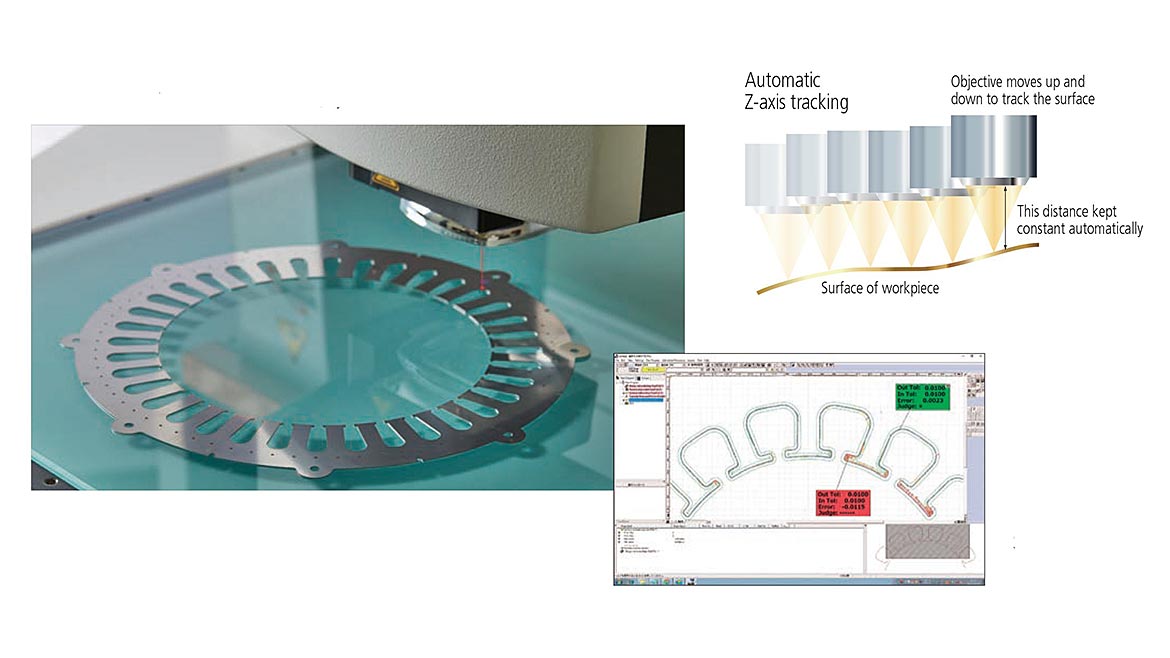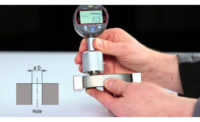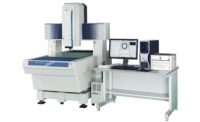Vision measurement has long-standing relationships with many industries, including businesses in the medical, aerospace, and automotive sectors. Manufacturers that make or inspect extremely small or highly sensitive parts often can’t rely on coordinate measurement machines (CMMs) or need other solutions.
Vision measuring machines (VMMs) offer several key benefits, such as greater speed, versatility, and efficiency – with many other exciting innovations on the way as well. These, combined with rapid growth in several emerging industries, may have businesses evaluating whether a vision measurement system could be a good fit for them.
But before taking the plunge, it’s important that manufacturers and machine shops fully understand what a vision measurement system is, how it differs from other measurement and inspection tools, and whether it would be a good fit for them.
How Vision Measurement Is Different
Fundamentally, vision measurement fills the same role as most other inspection tools, such as CMMs. Manufacturers use them to make sure that either the parts coming in, or the finished products coming out, meet a certain standard or quality.
However, unlike CMMs, vision measurement systems are ideal for applications where noncontact measurement is essential, or in high-throughput production. For example, many manufacturers in the medical, aerospace, and automotive industries utilize vision measurement systems for the benefits they provide.

Why Manufacturers Are Turning To Vision Measurement
While CMMs are great tools, a probe must physically touch the part or product to take a measurement. There’s a chance that a probe could damage or contaminate highly sensitive components, such as medical or aerospace equipment, by simply touching it, which is obviously not ideal. Vision measuring machines use highly precise sensors and cameras to take a contactless measurement of a part, eliminating the possibility that it could be damaged by a probe.
Additionally, some products and parts are simply too small to be effectively measured by a probe. Semiconductors, for example, are only a few nanometers in size. CMMs can still be used to take measurements, but a VMM with ultra-high-resolution images and processing capabilities is more practical and can be done more efficiently.
Using a CMM and probe to capture data points also takes time. For manufacturers that churn out large numbers of parts, or that need to inspect them quickly, using those tools can be inefficient and may eat into their bottom line. Vision measurement systems have exceptional throughput capabilities, and their rapid processing can achieve sample rates of hundreds of thousands of data points in seconds.
Vision Measurement, The EV Industry, And The CHIPS Act
Two exciting developments for the vision measuring industry are the rapidly expanding electric vehicle (EV) market, and the passage of the CHIPS and Science Act.
As the automotive industry moves from combustion engines to electric, vision measurement will take on an even bigger role in the construction of EVs.
In particular, the way EV motors are manufactured makes them an ideal candidate for a VMM. The motor itself is typically composed of several layers of rotors that are stamped and then stacked on top of each other and laminated together. When the parts are stamped, they must be inspected. Since some of the individual components are the thickness of a piece of cardboard, vision measurement is the most accurate way to conduct the inspection. Most CMM probes would have a difficult time measuring thick parts with any accuracy.
Another emerging and exciting development is the CHIPS and Science Act, which was passed by Congress in 2022. At its core, the act provides more than $52 billion* to strengthen, boost, and incentivize semiconductor production and supply chains in the United States. Currently, roughly 75 percent of semiconductors are produced in Asia. Vision measurement systems will be a key part of this massive manufacturing expansion.

The Future Of Vision Measurement
Vision measuring machines obviously aren’t new, having been around for a few decades. But several advancements hint at an exciting and innovative future that can potentially revolutionize the inspection industry.
- AI and automation: Artificial intelligence (AI) and automation can have a massive impact on the inspection industry, especially when it comes to detecting defects. When integrated into a VMM, an AI can be trained to detect defects, such as scratches, marks, or blemishes, removing the human element from the equation. And automating the inspection process can both speed it up and free the operator up to focus on other tasks.
- Remote status monitoring: Future vision measurement systems will have the ability to broadcast their operating status and condition. Operators or other staff can remotely see the status of the machine from a different area of the shop floor or even a different location altogether. They’ll be able to tell how long the machine has been running, what program is running, and the status of the machine itself, among other things. Importantly, this can help manufacturers proactively schedule maintenance and parts replacements before they become issues that take the machine offline.
- High-accuracy sensors: As CMOS cameras and sensors continue to improve their signal to noise ratio and become even more precise, they’ll enable vision measurement systems to become even more accurate and allow higher pixel counts. This will be especially important in the semiconductor and aerospace industries. It will also have the added benefit of helping improve inspection speed.
What To Consider Before Implementing A Vision Measurement System
The speed, accuracy, and precision of a vision measuring machine has evolved significantly over the last few years, making them more attractive to both manufacturers and machine shops. But those that are considering moving to vision measurement need to keep four key considerations in mind.
First, the installation and calibration of the vision system should be completed following strict procedures and using tools and artifacts that are accredited by the National Institute of Standards and Technology (NIST). To have earned NIST accreditation, the machine’s manufacturer must meet the Institute’s industry standards. Any machine can just do the measurements and spit out numbers, but when a machine’s installation and calibration is A2LA accredited, it means that the numbers it produces are true, accurate, and up to standard.
Next, make sure that the machine can measure the parts that are being manufactured. Can the machine accurately measure the part? Can it find the edge accurately? Can it get the lighting set up correctly? A demo may look flashy and exciting, but if the machine can’t measure the specific parts that a manufacturer creates, it won’t be a worthwhile investment.
Additionally, ensure that the machine and software are both powerful enough to do the job, but also flexible enough and easy to use and train others on. Striking that balance can often be a challenge. If the machine or software is too complicated, operators may find it so difficult to use and train others on that they simply don’t use it and the machine sits idle on the shop floor. On the other hand, if it’s too simplistic, the machine might not be flexible enough to get the measurements the manufacturer needs.
Finally, it’s always important to consider budget. Price is, of course, important, but it’s equally important to consider your needs in the context of how the machine will be used. A cheap machine might be budget friendly, but if it breaks too easily, it won’t be a worthwhile investment. Also, cheaper vision systems might not even be capable of getting the measurements you need, usually because its optics or software aren’t powerful enough. At the same time, a top-of-the-line machine won’t be a wise purchase if a business won’t be able to leverage all the benefits.
Is A Vision Measurement System Right For You?
Vision measurement systems offer a wide range of exciting possibilities and opportunities for manufacturers. And as technology and the systems themselves continue to evolve, they may prove to be a good fit for many businesses that are looking for greater speed, efficiency, and accuracy in the inspection process.
By evaluating your business’s needs and opportunities, you can see how a vision measurement system could fit into your inspection process.



